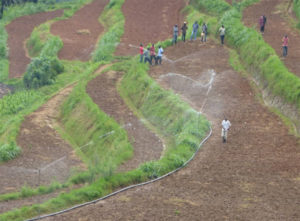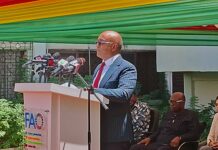In the past, during the dry season, small-scale farmers who depended on rainfall for farming almost become inactive and always waited for the rainy season to farm and till their lands.
In 2011, the Government of Rwanda in¬stalled new models of irrigation, pumping water from Nasho lakes, Kagera and Muvumba streams under the projects known as Nasho Lot 1, 2 and Kagitumba Matimba irrigation projects, respectively located in Kirehe and Nyagatare districts. The fragmented individual plots of farmers have been consolidated under the newly introduced irrigation technology known as centre pivots, sprinkler and drip systems.

The farmers who received irrigation systems have witnessed an increase in their yield, growing crops three times a year and filling their pockets with money harvested from the formerly less productive land. These schemes have served much as role models in the development of subsequent schemes in the vicinity as well as in other drought-prone areas of the country.
Since 2004, the Ministry of Agriculture and Animal Resources (MINAGRI) has developed and implemented three phases of the Strategic Plan for the Transformation of Agriculture (PSTA), the main policy framework for agriculture development in Rwanda. It is aimed at harmonizing the agriculture sector development activities with the national Economic Development and Poverty Reduction Strategies and Vision 2020. In 2014, the government of Rwanda through MINAGRI embarked on a project that has seen many farmers’ lives improve by leaps and bounds. Many have seemingly been turned into overnight millionaires. Last year, MIN¬AGRI embraced PSTA 4, as a new driver of the sector’s transformation. Under its Priority 2 of productivity and resilience, appear irrigation, sustainable land husbandry and agriculture mechanization, with ambitious targets for 2024.
Water resource development has been acknowledged to be a primary solution to minimize the dependence of subsistence farming on unpredictable rainfall. According to Hanson Micomyiza, the Acting Head of Department of Irrigation Development, Land husbandry and Agriculture Mechanization at Rwanda Agriculture Board (RAB), the country aims to increase the development of irrigation facilities and effective management of existing ones.
The the sector will increase new water irrigation infrastructure from 51,178 Ha today to 102,284 Ha by 2024. This tar¬get will be achieved through various forms of development partnership with NGOs, private sector and international funding organizations. These interventions will target the eastern and southern parts of the country, where yield is constrained by unreliable and less rain. Around 10,834 Ha of new large hillside developments are ongoing and others are expected in the most drought-prone districts, namely Nyagatare, Kirehe, Ngo¬ma, Kayonza, Nyanza and Kirehe.

On the other hand, marshland development will also proceed mostly in the southern and western parts of the country. The decentralized and subsidiary irrigation program is projected to cover up to 3,000 Ha annually, and contribute to the national targets. This will benefit smallholders who produce vegetables and fruits, and help them to be productive in a cost-effective manner. Solar-powered systems are also becoming prominent solutions and are delivered in partnership with an NGO known as Energy for Impact, Rwanda.
Located in Munyiginya sector, Nyarubuye cell, Rwamagana district, is Farm Gate East Africa Ltd. It is a farm that started its operations in May 2018 and sits on 8.5 hectares of irrigated land. Though it is January and the dry season is not here yet, Justin Habimana, the farm manager, is busy setting up a rain gun irrigation sprinkler to spray beans that have been recently planted. Around him, the tilled land spreads out over a large area behind him. He says that though their main crop is fresh beans, they grow different crops throughout the year.
The farm is 8.5 hectares and, on a rotational basis, they plant ginger, garlic, fruit melon, water melon, white onions, broccoli, cucumber and hot pepper, colored sweet pepper and baby corn. “We have plans of increasing the land under irrigation from 8.5 to 15 hectares. We irrigate our land through¬out the year according to the requirement of the crops and the water levels,” says Habimana.
The farm uses different equipment for irrigation that helps triple production. According to the farm manager, they use two ways of irrigation. They sometimes use gravity to ferry water to the fields and at times they use pressure by pumping the water from the three dam sheets. “We use dam sheets to capture water from Lake Muhazi to our reservoir. Here the main pipe collects water from the reservoir to the sub-main pipe and after it’s filtered, we use the T-Tape to ferry water from the sub-main pipe to the fields,” says Habimana. They also have a sprinkler which is effective and does not require anyone to operate it since the water is spread throughout the patch of nursery beds that need to be irrigated.

Farm Gate East Africa has created jobs for close to one hundred youth and women. On a daily basis, there are over 100 people working on the farm doing various activities from preparing land for planting, planting and tending to the various crops. “Given the availability of water all year round, the farm is always growing something and harvesting is done throughout the year which gives us an advantage over the rest of the farmers who don’t irrigate their land,” says Habimana.
The farm manager admits that because of the availability of water year-round, they irrigate according to the need and that makes the quality of their crops better compared to other farmers.
He, however, says that they do face some challenges when it comes to irrigation and that the main challenge is the cost of the irrigation system. “It takes a lot not only acquiring the equipment but also the cost of maintenance is very high. We need many experienced and trained workers and scouts who check out the broken pipes and also do repairs when the system breaks down,” Habimana explained.
In 2016, a Rwf 2.2 billion Rugende marshland project of the Rural Sector Support Project (RSSP3), initiated by the Ministry of Agriculture and Animal Resources, was implemented to enhance rice and horticulture production, as well as fodder growing.
In 2017, the Governments of Rwanda and Japan sealed a $18.8-million (about Rwf 16 billion) financing agreement to support irrigation farming in Rwamagana district in Eastern Province. The project was designed to help farmers utilize agricultural water accumulated at four dams in Eastern Province more efficiently and promote intensive farming.
Small-scale irrigation is the answer to climate change, ensuring crop productivity. Given that climate change is now a global issue, relying on rain-fed irrigation is hard and farmers need to be as innovative in adopting small-scale irrigation as they are in adopting improved seeds and fertilizer inputs, but also harvest rainwater during the rainy season which they can use for irrigation during the dry seasons and also for their livestock.
According to Hanson, using machines in different farm activities is expected to increase yield and save both farm operation time and expenditures. The agriculture sector shall move from the current 41,000 Ha under permanent mechanization to 100,000 Ha by 2024. This will be driven by the private sector and is expected to evolve more by locally manufacturing the farm implements and service provision. Another focus will be put in mechanizing post-harvest handling to reduce yield loss and add value to production.
RAB conducts mobilization campaigns at the grassroots level to encourage farmers to buy tanks and dam sheets to collect and store water. Both water tanks and dam sheets are bought at government subsidized prices.
The government will also keep protecting the landscape from soil erosion, a source of soil fertility decline on most agricultural land in Rwanda. Land under erosion control measures will be extended from 1,034,509Ha in 2017, up to 1,495,624 Ha by 2024 using radical and progressive terraces, biological soil conservation practices, and planting agro-forestry species.








